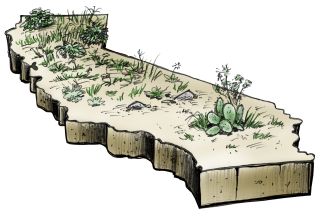Colorado River water supply to fall short of demand, study says
Water demand in the Colorado River Basin will greatly outstrip supply in coming decades as a result of drought, climate change and population growth, according to a broad-ranging federal study.
It projects that by 2060, river supplies will fall short of demand by about 3.2 million acre-feet — more than five times the amount of water annually consumed by Los Angeles.
“This study should serve as a call to action,” U.S. Interior Secretary Ken Salazar said Wednesday as he released a report that predicted a drier future for the seven states that depend on the Colorado for irrigation and drinking supplies. “We can plan for this together.”
The analysis lists a range of proposed solutions, including some that Interior officials immediately dismissed as politically or technically infeasible. Among them: building a pipeline to import water from the Missouri or Mississippi rivers and towing icebergs to Southern California.
But Salazar said a host of practical steps could be pursued, including desalination of seawater and brackish water, recycling and conservation by both the agricultural and urban sectors.
The U.S. Bureau of Reclamation study, authorized by Congress, acknowledges the uncertainties in trying to project supply and demand over the next 50 years. Environmental groups, while praising parts of the report, said it overestimated population growth and thus inflated future water demand.
Water managers have known for years that long-term average flows in the Colorado are not as great as they were early in the last century, when the river’s supplies were divvied up among the states. Compounding that is a warming climate, which is expected to increase evaporation, decrease the snowpack and accentuate drought.
The report cites projections in previous studies that climate change could reduce flows from the upper Colorado basin by about 9%.
In conducting the analysis, the reclamation bureau worked with the basin states — Arizona, California, Colorado, New Mexico, Nevada, Utah and Wyoming — as well as agricultural, environmental and tribal groups and water agencies.
The study developed demand and supply scenarios involving a range of population growth estimates, which the authors saw as the principal driver of increased demand.
But environmental groups said those estimates were based on state projections before the Great Recession, noting that the real estate collapse popped the growth balloons in such cities as Las Vegas and Phoenix.
“Some of these demand projections are absurd,” said Michael Cohen, who is based in Colorado and is a senior associate with the Pacific Institute, an Oakland think tank.
He was nonetheless encouraged by the report’s discussion of the potential for conservation by cities and farms. “Those kinds of options are already in practice in the basin and they are cheaper and faster” than building major infrastructure projects such as desalination plants, he said.
Agriculture uses most of the developed water supplies in the West and the future is bound to bring more transfers of water from farms to cities, Cohen said. But that could be largely accomplished by selling the water that is conserved through more efficient irrigation practices rather than by retiring farmland, he said. “There’s a lot of waste in the system in the ag end and the urban end.”
The single biggest allocation on the river goes to California’s Imperial Irrigation District, which is fallowing some fields and selling water to San Diego as part of a pact orchestrated a decade ago by Interior. The transfers have been controversial in the district, and Kevin Kelley, the agency’s general manager, warned that carrying out such agreements can be tougher than planning them.
He also worried that his district would come under pressure to make more transfers. “We don’t want to get into a zero-sum game in which one category of user wins and another, chiefly agriculture, has to lose,” he said.
The reclamation bureau received more than 150 ideas for solving the coming shortages and included ones considered far-fetched.
Salazar emphasized that the agency had no plans to pursue such ideas as towing water bags to Southern California or piping water from the Northwest or the Mississippi River basin. “In my view, those solutions are impractical and technically not feasible,” he said.
Barry Nelson, a senior policy analyst with the Natural Resources Defense Council, said that with the report, the reclamation bureau — the traditional builder of the West’s biggest water supply projects — was entering “a new era in management of the Colorado River.”
“They have painted a picture that is undeniable,” he said. “The history of developing new water in the Colorado River Basin is over.”
More to Read
Sign up for Essential California
The most important California stories and recommendations in your inbox every morning.
You may occasionally receive promotional content from the Los Angeles Times.











